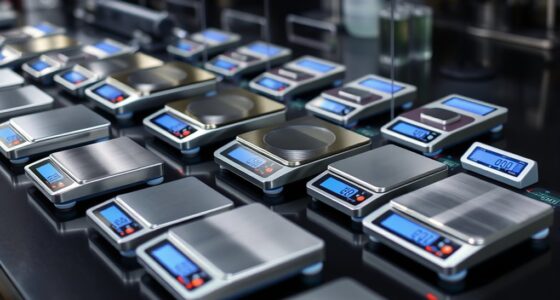If you’re looking for the best top-loading balances for chemistry labs, I recommend models like the Hanchen, CGOLDENWALL, JOANLAB, and U.S. Solid, which offer high precision, ranging from 0.01g to 1mg, and feature durable builds and multiple measurement units. These scales support calibration and connectivity options that guarantee consistent, reliable results. For a detailed overview of each, keep going — you’ll find all the info you need to choose the perfect balance.
Key Takeaways
- Choose balances with 0.01g or higher resolution for accurate chemical measurements.
- Prioritize models with calibration features and external weights to maintain long-term precision.
- Opt for balances with durable materials, sturdy construction, and protective shields for reliable lab use.
- Ensure models support multiple units and data connectivity options like USB or RS232 for versatility.
- Select balances with quick stabilization times and user-friendly controls for efficient laboratory workflows.
Lab Scale 5000gx0.01g Digital Laboratory Balance

If you’re looking for a highly precise balance for scientific or laboratory use, the Lab Scale 5000gx0.01g Digital Laboratory Balance is an excellent choice. I appreciate its high accuracy of 0.01 grams, which guarantees reliable results quickly, thanks to its upgraded sensor and fast stabilization time of five seconds or less. The large stainless steel pan handles chemicals, powders, jewelry, and small items comfortably. It offers versatile measurements, supporting grams, ounces, carats, and pounds, and features a clear LED display. With built-in calibration and overload alarms, it’s designed for durability and precision, making it perfect for demanding laboratory tasks.
Best For: scientists, laboratory technicians, jewelers, pharmacists, and industrial users requiring high-precision and reliable measurements.
Pros:
- Highly accurate with 0.01g precision ensuring reliable results
- Large stainless steel pan suitable for various small items and chemicals
- Supports multiple units of measurement (g, oz, ct, lb) for versatility
Cons:
- Does not include batteries, requiring external power sources
- Calibration requires external weights and setup, which may be inconvenient
- Preheating time can range up to 30 minutes before use
CGOLDENWALL 5000g Laboratory Balance
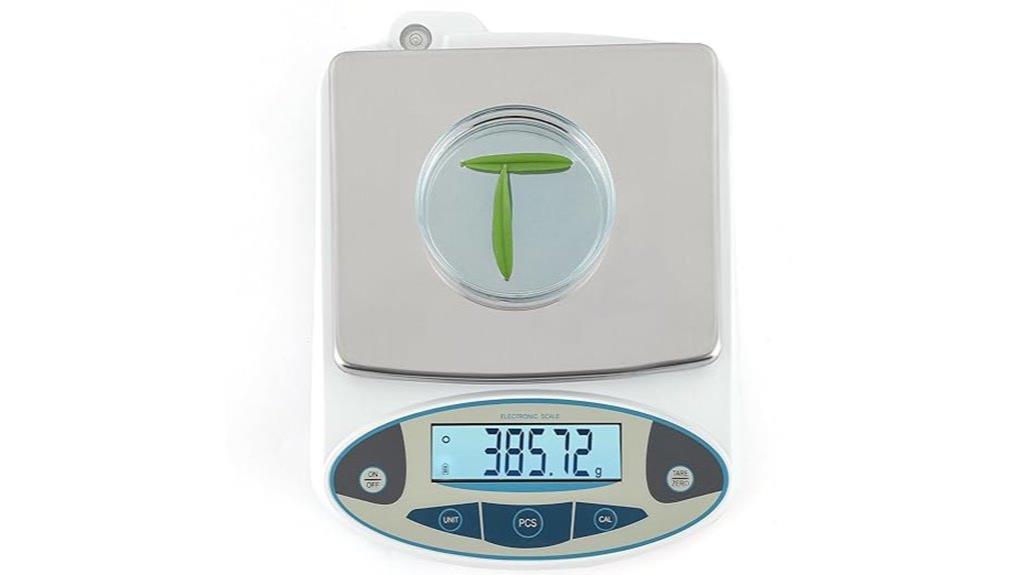
The CGOLDENWALL 5000g Laboratory Balance stands out for those who need precise measurements of larger quantities in a compact, durable design. It offers 0.01g accuracy with a high-sensitivity sensor, perfect for fine powders like mica. The scale features 13 unit conversions, tare, counting, and calibration functions, with adjustable feet and a built-in leveling device ensuring consistent accuracy. Constructed from sturdy ABS with a stainless steel weighing pan, it has a clear, backlit LCD display. While calibration is straightforward, some users note the need for external weights and minor durability concerns, especially with the power supply. Overall, it’s a reliable, precise choice for larger lab measurements.
Best For: users who need precise, large-quantity measurements in a durable, compact lab scale suitable for fine powders and various weighing tasks.
Pros:
- High-precision 0.01g accuracy with a sensitive sensor for reliable measurements
- Multiple unit conversions (13 options) and useful functions like tare, counting, and calibration
- Sturdy ABS construction with a stainless steel pan and clear backlit LCD display for easy reading
Cons:
- External calibration weights are necessary for the 5000g model, as no weights are included
- Difficulties fitting the battery compartment and concerns over power supply durability
- Some users report plastic quality issues and limited language support, affecting long-term durability and usability
Eosphorus Science Digital Scale (0.01g Accuracy)
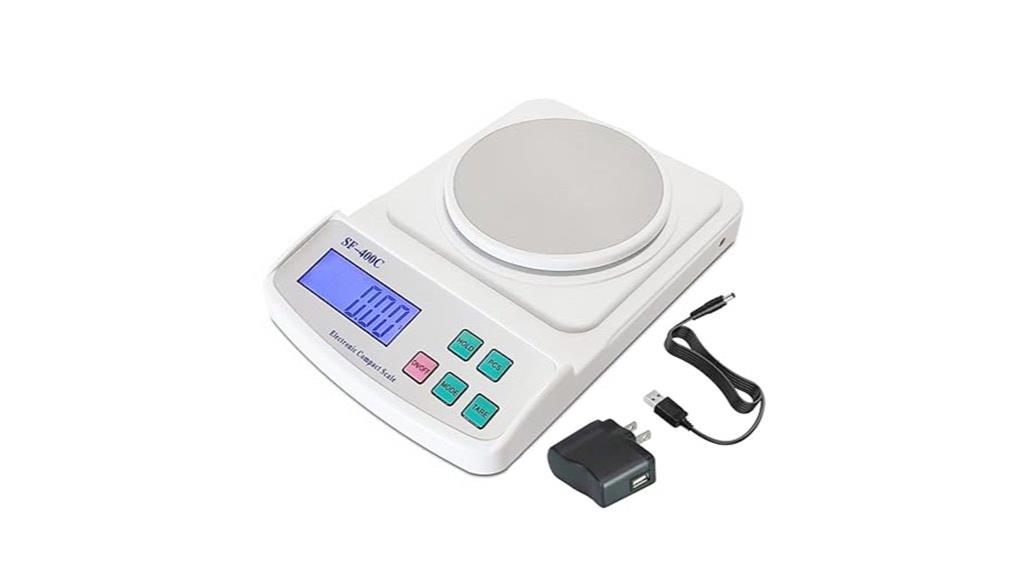
The Eosphorus Science Digital Scale excels for those needing precise measurements up to 0.01 grams, making it ideal for chemistry labs where accuracy is critical. It features a strain gauge sensor for fast, reliable readings, supporting a range up to 600 grams. The scale offers six units, including grams, ounces, and piece counting, with a large, backlit LCD for easy reading. Its pre-calibration guarantees consistent performance, and external calibration is accessible if needed. Powered via USB, AC/DC, or batteries, it’s versatile and user-friendly. Durable and compact, this scale provides dependable precision for chemical measurements, small-scale production, or educational purposes.
Best For: individuals and professionals who require precise, reliable measurements up to 0.01 grams for laboratory, scientific, or small-scale production applications.
Pros:
- Highly accurate with 0.01g precision, suitable for sensitive measurements.
- Supports multiple units including grams, ounces, pounds, kilograms, and piece counting.
- Bright, large LCD display ensures easy readability from any angle in various lighting conditions.
Cons:
- Less consistent accuracy for objects weighing under 0.1g.
- Some users report calibration issues or malfunction after extended use.
- May experience initial defects or damage if not stored or handled properly.
Eosphorus Science Digital Scale Laboratory Balance (SF460-S-Blue)
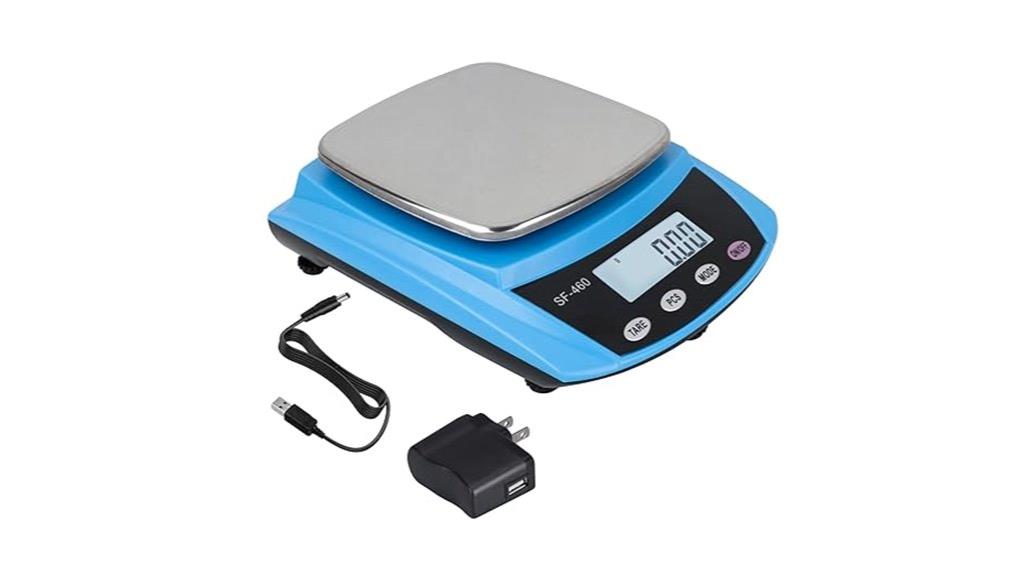
Designed for versatility and precision, the Eosphorus Science Digital Scale SF460-S-Blue stands out as an excellent choice for educators, jewelers, and home cooks who need reliable measurements in a compact form. It offers 0.01g accuracy and supports measurements up to 600g, with seven units including grams, ounces, and carats. The scale features a large, backlit LCD, a removable stainless steel pan, and multiple power options—USB, AC/DC, or batteries—making it adaptable for various settings. Despite its lightweight plastic build, it’s durable and easy to calibrate. Overall, it provides consistent, accurate results for small-item weighing, making it a practical tool for precise measurements.
Best For: educators, jewelers, and home cooks who need reliable, precise measurements in a compact and versatile digital scale.
Pros:
- High precision with 0.01g accuracy suitable for delicate measurements
- Supports multiple units including grams, ounces, and carats for versatility
- Multiple power options (USB, AC/DC, batteries) for portability and convenience
Cons:
- Plastic housing may feel brittle and is susceptible to cracking if dropped
- Lacks arresting gear for the weighing pan, which can affect stability during use
- Calibration can be tricky without proper weights or instructions, requiring some trial and error
Eosphorus Science Digital Scale Laboratory Balance
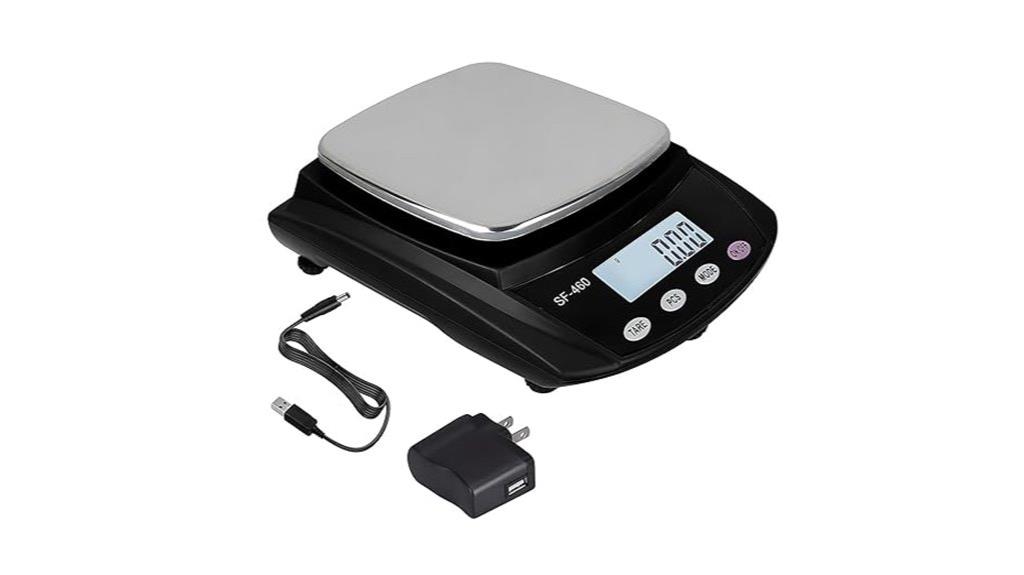
If you need a highly accurate and versatile scale for precise measurements in a scientific or jewelry setting, the Eosphorus Science Digital Scale Laboratory Balance is an excellent choice. It offers 0.01g accuracy with a strain gauge sensor for fast, reliable readings. Supporting weights up to 600g, it features a large, removable stainless steel pan and an embedded bubble level for proper setup. The LCD display is bright and easy to read from any angle, even in low light. With multiple measurement units, tare function, and user-calibrated options, it delivers consistent precision. Its portability and multiple power options make it suitable for labs, kitchens, or classrooms.
Best For: those in scientific, jewelry, culinary, or postal fields requiring highly precise, versatile measurements up to 600g.
Pros:
- High accuracy of 0.01g with quick, reliable strain gauge sensor readings
- Supports multiple measurement units and has a tare function for convenience
- Bright, large LCD display with backlighting for easy reading from any angle
Cons:
- Calibration issues or difficulty leveling may affect measurement accuracy
- Limited maximum weight capacity (around 600g) may not suit all kitchen or postal needs
- Larger size compared to typical kitchen scales might reduce portability or storage convenience
Eosphorus Science Digital Scale Laboratory Balance
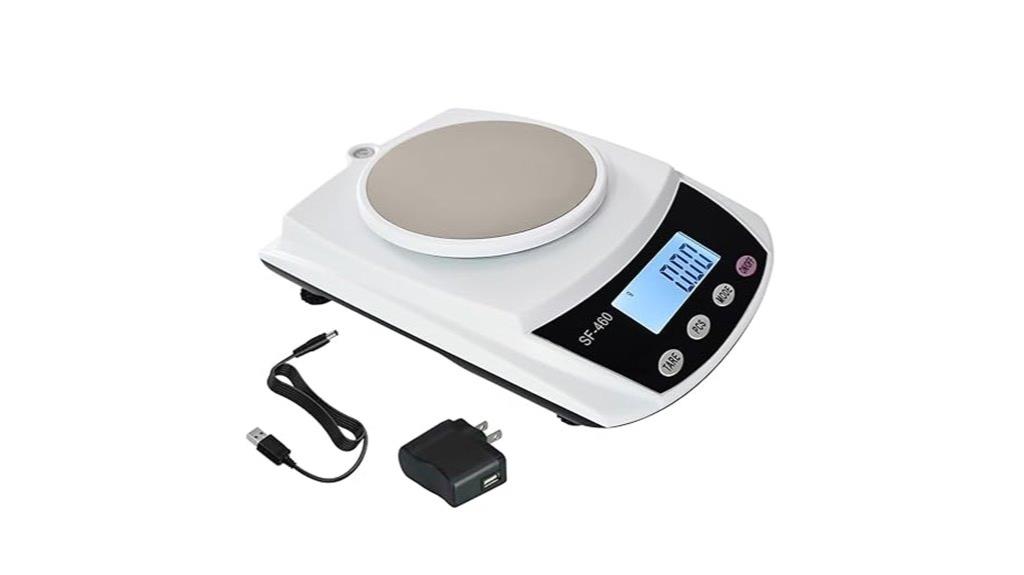
For those seeking precise and versatile measurements in laboratory or jewelry settings, the Eosphorus Science Digital Scale Laboratory Balance stands out with its 0.01g accuracy and multi-unit support. It features a high-precision strain gauge sensor for quick, reliable readings up to 600 grams. The large, backlit LCD ensures easy visibility from any angle, while the tare function simplifies weighing containers. Its sturdy stainless steel pan, bubble level, and adjustable non-slip legs enhance stability. Powered via USB, AC/DC adapter, or batteries, it offers flexibility. Pre-calibrated and user-adjustable, this scale is ideal for lab, jewelry, and food applications, delivering accuracy and ease of use.
Best For: those needing precise, versatile measurements in laboratory, jewelry, food, or mailing applications who value accuracy and multiple measurement units.
Pros:
- High-precision 0.01g measurement accuracy suitable for sensitive weighing tasks
- Supports multiple units including g, oz, lb, ct, and pcs for versatile use
- Large, backlit LCD display ensures clear visibility in various lighting conditions
Cons:
- Reports of durability issues, with some users experiencing failure within months
- Requires external calibration for adjustments, which may be complex for some users
- Battery operation might be inconvenient without frequent replacements or backup power
Hanchen Analytical Balance 220g/0.1mg Digital Lab Scale
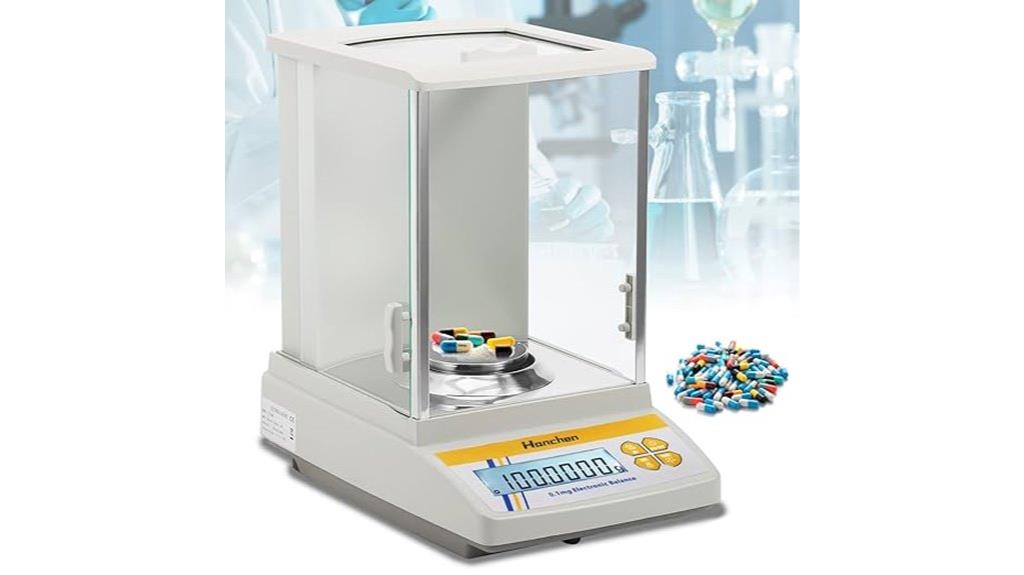
The Hanchen Analytical Balance 220g/0.1mg stands out as an ideal choice for laboratories and jewelry stores that demand high precision and reliable data transfer. Its 0.1mg resolution and 220g capacity ensure accurate measurements for analytical and jewelry applications. The balance features efficient RS232 connectivity, enabling seamless data export and analysis with third-party software. Its three-sided glass draftshield, aluminum alloy chamber, and robust metal base provide stability and protection from air currents and temperature fluctuations. With quick stabilization within three seconds, a backlit LCD display for visibility, and multiple unit conversions, it offers versatility and dependable performance for precision weighing needs.
Best For: laboratories, jewelry stores, and research facilities requiring high-precision weighing and reliable data transfer.
Pros:
- High precision with 0.1mg resolution and 220g capacity, suitable for analytical and jewelry applications
- Efficient RS232 connectivity for seamless data export and integration with third-party software
- Robust construction with a glass draftshield and aluminum alloy chamber ensures stability and protection from environmental disturbances
Cons:
- Limited capacity of 220g may not suit heavier weighing needs
- Requires calibration by professional services, which may involve additional costs
- The compact size might restrict use in applications requiring larger or multiple samples at once
SUPER DEAL Electric Lab Centrifuge Machine, 4000 RPM, 20ml Capacity, Desktop Model
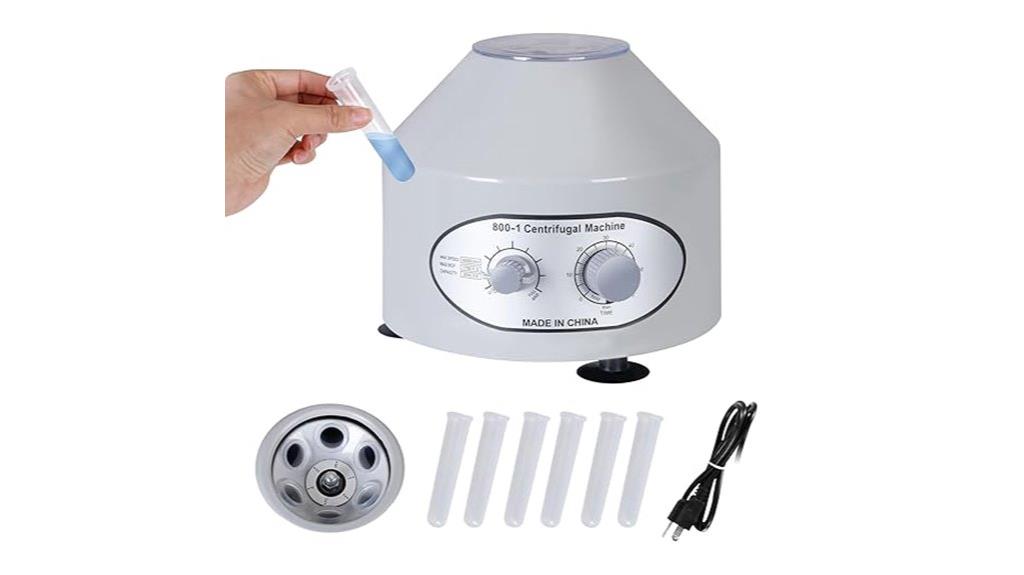
Designed for laboratory, medical, and educational environments, the SUPER DEAL Electric Lab Centrifuge Machine offers a reliable solution for separating liquids from solids or particles based on density. With a maximum speed of 4000 RPM and a 20 ml capacity per tube, it’s suitable for cell separation, herbal clarification, and radioactivity assessment. Its compact, lightweight design makes it perfect for home, classroom, or medical use. Made of durable metal, it’s stable during operation. Easy to operate with straightforward controls, but balancing tubes precisely is essential to prevent noise or damage. Despite heating up during extended runs, it remains a dependable, cost-effective tool for various lab tasks.
Best For: laboratories, medical professionals, educators, and home users seeking a reliable and affordable centrifuge for cell separation, herbal clarification, or small-scale sample processing.
Pros:
- Compact and lightweight, ideal for various environments including home, classroom, and medical labs
- Durable construction with high-quality metal for stability and longevity
- Easy to operate with straightforward controls and reliable performance over multiple runs
Cons:
- Heating during extended operation can reach high temperatures, posing safety risks and affecting samples
- Plastic lid is cheap and may detach if mishandled, requiring careful handling
- Requires precise balancing of tubes to prevent noise, vibration, and potential damage
JOANLAB Analytical Balance 200g x 1mg Digital Lab Scale
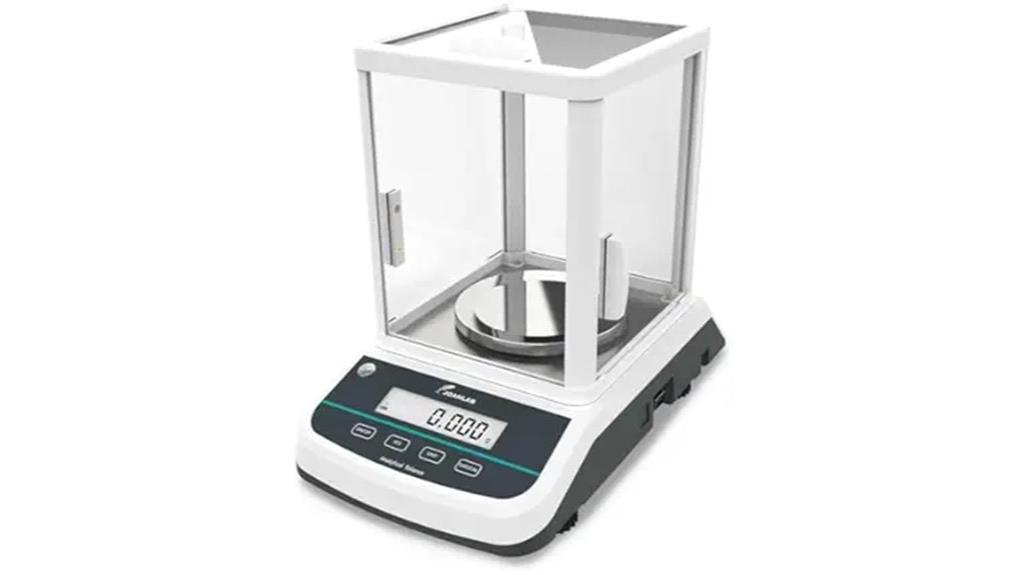
Looking for a highly precise balance for detailed chemical measurements? The JOANLAB Analytical Balance 200g x 1mg delivers exceptional accuracy with 0.001g precision and a 200g capacity. Its dual-display design makes readings easy from both front and rear, while the sturdy platform and sliding glass doors protect against environmental factors. Features like a bubble level and adjustable feet guarantee perfect leveling for reliable results. Supporting multiple units and functions—such as check weighing and piece counting—this balance is versatile. With connectivity options like RS-232 and a backlit LCD, it’s ideal for labs, pharmacies, and jewelry stores demanding consistent, precise measurements.
Best For: professionals and laboratories requiring highly precise measurements for chemical, pharmaceutical, jewelry, or research applications.
Pros:
- High accuracy with 0.001g precision and reliable repeatability.
- Versatile functions including check weighing, piece counting, and multiple unit support.
- Sturdy construction with protective glass doors and dual-display for easy, clear reading.
Cons:
- Some users report high-pitched noise from the power adapter, which may be distracting.
- USB port functionality was not specified, potentially limiting connectivity options.
- The device requires proper leveling and calibration for optimal performance, which may add setup time.
U.S. Solid 1mg Analytical Balance Digital Lab Scale
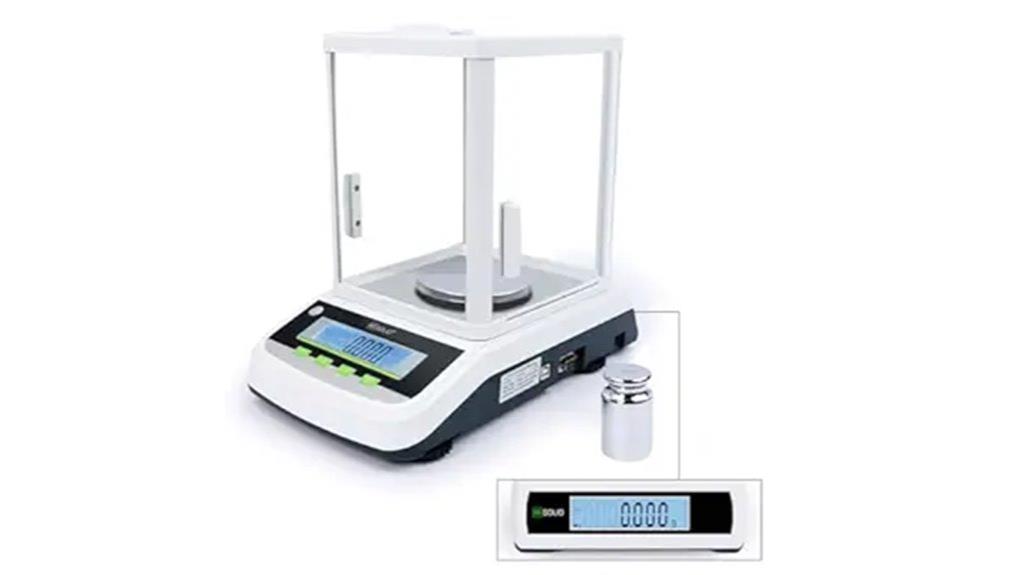
If you need pinpoint accuracy in your chemistry lab, the U.S. Solid 1mg Analytical Balance Digital Lab Scale is an excellent choice. It features two LCD screens for easy reading and an adjustable backlight for visibility in any setting. The durable glass windshield with slide-doors protects against drafts, while the oversized 9 cm stainless steel pan accommodates various samples. With a 1mg precision and a maximum capacity of 300g, it supports 19 measurement units. Connectivity options include USB and RS232 interfaces for data transfer, and it offers overload protection, tare, piece counting, and manual calibration for reliable performance.
Best For: researchers and lab technicians requiring precise and reliable measurements for small samples in chemistry or related fields.
Pros:
- High-precision 1mg measurement capability with a maximum capacity of 300g.
- Dual LCD screens and adjustable backlight enhance readability in various environments.
- Multiple connectivity options (USB and RS232) facilitate easy data transfer and documentation.
Cons:
- Requires external power supply or batteries, which are not included.
- Limited to a maximum weight of 300g, not suitable for larger samples.
- May be more expensive than basic scales due to advanced features and precision.
Lab Scale 300g×0.001g High Precision Analytical Balance

For those performing high-precision chemical measurements, the Lab Scale 300g×0.001g High Precision Analytical Balance is an excellent choice. It offers a 0.001g resolution with a 300g capacity, ensuring accurate weighing of small samples. The balance features a stable sensor, a calibration process with a 200g weight, and a large LED display for easy readings. Its stainless steel pan, wind shield, and adjustable leveling feet enhance stability. Designed for laboratory, industrial, and educational use, it delivers quick, reliable results. Despite some stability concerns and calibration hints, this scale’s precision and features make it ideal for demanding scientific tasks.
Best For: scientists, laboratory technicians, and students requiring high-precision weighing for chemicals, powders, or small components.
Pros:
- Offers exceptional 0.001g resolution with a maximum capacity of 300g for precise measurements.
- Features a stable sensor and calibration with a 200g weight to ensure high accuracy.
- Equipped with a large LED display, stainless steel pan, and wind shield for reliable performance in various environments.
Cons:
- Sensitivity to external air currents may cause fluctuations; requires a windshield for optimal stability.
- Calibration instructions are somewhat vague, potentially complicating the process for new users.
- The scale’s delicate sensor and sharp glass edges demand careful handling to prevent damage or injury.
Factors to Consider When Choosing a Top‑Loading Balance for Chemistry Labs

When choosing a top-loading balance for your chemistry lab, I look at several key factors to make certain it meets your needs. You should consider measurement precision, calibration features, durability, ease of use, and portability. Focusing on these points helps you select a reliable balance that fits your specific laboratory tasks.
Measurement Precision and Range
Choosing the right top-loading balance hinges on matching its measurement precision and range to your specific laboratory needs. First, verify the balance’s minimum readability (like 0.01g or 0.001g) aligns with the precision your experiments require—more sensitive measurements demand finer readability. Next, confirm that the maximum weighing capacity covers your heaviest samples, preventing overload errors. Consider if the balance supports multiple units, such as grams, ounces, or carats, to enhance versatility. Additionally, check for tare and calibration functions to maintain accuracy across different measurements. Finally, assess the stabilization time; a quick response (≤5 seconds) ensures efficient workflow and reliable readings. Balancing these factors guarantees you select a balance that meets both precision standards and operational demands.
Calibration and Accuracy Features
Calibration and accuracy features play a crucial role in guaranteeing your top-loading balance delivers reliable measurements over time. I look for balances with precise calibration options, including external calibration capabilities, to maintain accuracy. It’s important that the balance supports calibration adjustments and comes with calibration weights or makes them easily accessible. A linear error margin of ±0.03g or better guarantees precise results, which is essential in chemistry labs. Quick stabilization time, ideally under five seconds, helps me get rapid, accurate readings, especially during busy experiments. Proper calibration procedures, regular recalibration, and features like built-in level indicators and adjustable leveling feet are vital for maintaining consistent accuracy. These features guarantee your balance remains reliable for precise chemical measurements, saving time and reducing measurement errors.
Durability and Build Quality
Durability and build quality are essential factors because a top-loading balance must withstand the demanding conditions of a busy chemistry lab. I look for models built with high-quality materials like stainless steel or reinforced plastic, ensuring they can resist daily wear and tear. The weighing pan and body should tolerate corrosion, chemicals, and impacts, maintaining accuracy over time. Reinforced leveling feet and vibration-resistant features help keep readings stable despite environmental disturbances. Protective elements such as shatterproof glass or sealed enclosures shield sensitive parts from dust, debris, and air currents. Overall, a well-constructed balance minimizes calibration drift and reduces maintenance costs, making it a reliable tool for long-term use. Investing in sturdy build quality is key to ensuring consistent, precise performance in a demanding lab setting.
Ease of Use and Interface
An intuitive interface is essential when selecting a top-loading balance for chemistry labs, as it guarantees smooth and error-free operation. Clear labels on buttons and a straightforward menu system make it easy to navigate functions like tare, calibration, and unit conversion, saving time and reducing mistakes. A large, backlit LCD screen enhances visibility in various lighting conditions, ensuring accurate readings without eye strain. User-friendly controls, including quick-start options and memory presets, streamline setup and repetitive tasks. Simple instructions and minimal menu complexity help users learn the device quickly, which is especially valuable in fast-paced lab environments. Overall, an easy-to-use interface promotes efficiency and confidence, allowing scientists to focus on their experiments rather than grappling with complicated controls.
Power Options and Portability
When choosing a top-loading balance for chemistry labs, considering its power options and portability is essential for ensuring flexibility and convenience. I look for balances with multiple power sources, like AC adapters, USB power, or batteries, so I can adapt to different lab environments. Portable balances with rechargeable batteries allow me to move between labs or perform fieldwork without worrying about power outlets. I also check battery life and charging requirements, especially if I’ll be using the balance extensively or in areas with limited electrical access. External power options, such as USB or AC/DC adapters, add convenience but might affect portability depending on setup. Ensuring compatibility with my lab’s infrastructure and easy access to replacement batteries or adapters is vital for smooth, reliable operation.
Frequently Asked Questions
What Maintenance Procedures Are Required for Top-Loading Balances?
When it comes to maintaining top-loading balances, I always start by regularly calibrating them with certified weights to guarantee accuracy. I keep the surface clean and free of dust or spills by gently wiping with a soft, damp cloth. I also avoid overloading the balance and check for any signs of wear or damage. Periodic servicing by professionals helps keep my balance reliable and precise over time.
How Do Environmental Factors Affect Balance Accuracy?
Think of a balance as a delicate tightrope walker, sensitive to every gust of wind. Environmental factors like temperature fluctuations, humidity, and air currents can sway its accuracy, much like gusts can wobble a performer. I’ve seen how drafts or vibrations throw off measurements. To keep precision, I always guarantee the balance is in a stable, draft-free environment, and I calibrate regularly to maintain reliable results.
What Is the Typical Lifespan of a Lab Balance?
The typical lifespan of a lab balance usually ranges from 5 to 10 years, depending on usage and maintenance. I’ve found that regular calibration and proper handling can extend its life considerably. Investing in quality models also helps guarantee longevity. If you keep the balance in a stable environment and avoid rough handling, it can serve you reliably for many years, making it a worthwhile investment.
Are There Specific Calibration Standards for Top-Loading Balances?
Calibration standards for top-loading balances are vital to maintain accuracy and reliability. I recommend using certified calibration weights that meet traceability standards like OIML or ASTM. Regular calibration, ideally before each use, ensures consistent results. Some balances have automatic calibration features, but manual calibration with certified weights is the most dependable method, especially for precise measurements needed in chemistry labs.
How Do User Errors Impact Measurement Reliability?
User errors can ensure impact measurement reliability. When I mishandle the balance, like not tare correctly or placing items unevenly, I introduce inaccuracies. Rushing or not following proper procedures also skews results. To guarantee precision, I double-check my technique, handle the balance carefully, and stay attentive during measurements. Minimizing these errors helps me achieve consistent, reliable data in my lab work.
Conclusion
Choosing the right top-loading balance might seem overwhelming, but with these options, you can find one that guarantees precision and reliability. I know some worry about cost or complexity, but investing in a quality lab scale saves you time and guarantees accurate results every time. Don’t settle for less—these balances are designed to meet your needs, so you can focus on your experiments without second-guessing your measurements.



